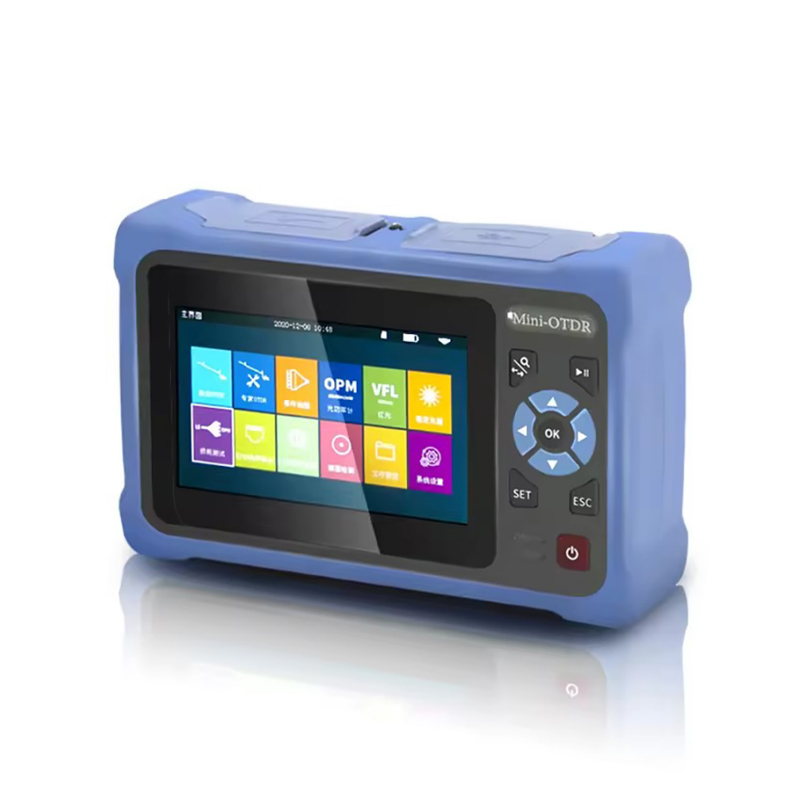Product
- Pre-Connectorized ODN Solution
- Fiber Optic Fast Connector
- Fiber Optic PLC Splitter
-
Fiber Optic Patch Cord
- SC series Fiber Optic Patch cord
- LC Series Fiber Optic Patch cord
- FC Series Fiber Optic Patch cord
- ST Series Fiber Optic Patch cord
- OM1/2 Fiber Optic Patch cord
- OM3 Fiber Optic Patch cord
- OM4 Fiber Optic Patch cord
- Armored Series Fiber Optic Patch cord
- E2000 Series Fiber Optic Patch cord
- Pigtail Fiber Optic Patch cord
- 12 Multi Colors Fiber Optic Patch cord
-
Fiber Optic Cable
- Fiber Optic Distribution Box
- Fiber Optic Splice Closure
-
Fiber Optic Terminal Box
-
ODF Fiber Optic Distribution Frame
- Fiber Optic Accessories
- Fiber Optic Equipment&Tool
OTDR Supplier
OTDR Fiber Optic Equipment is a professional device used for testing and troubleshooting fiber optic networks.
Accurate measurement and positioning: OTDR Fiber Optic Equipment can accurately measure the length, loss, reflection events and location of fault points of fiber optic links by injecting light pulses and analyzing the backscattered and reflected signals in the optical fiber. These features make it a key tool to ensure the reliability and performance of fiber optic networks.

Ningbo Goshining Communication Technology Co., Ltd. is an enterprise that designs, produces, and sells a full range of fiber optic products with high-quality and first-class services, which enable us to meet all customers' demands and offer one-stop service. Ningbo Goshining Communication Technology Co., Ltd is a professional Custom OTDR Supplier and OEM OTDR Company, our products include Fiber Optic Fast Connector, Patch Cord, PLC Splitter, Cables, Distribution Box, Splice Closure, and Terminal Box etc. We also offer Customization services to help develop your own brand.
-
Nov 21, 2025_GoshiningIn building high-performance fiber optic communication networks (especially passive optical networks (PONs) such as EPON and GPON), fiber optic PLC splitters (PLC splitters, planar waveguide circuit splitters) are crucial passive devices. M...Read More
-
Nov 17, 2025_GoshiningFrom May 15th to 17th, 2025, Ningbo Goshining Communication Technology Co., Ltd. successfully participated in the 20th China Optics Valley International Optoelectronic Exposition held in Wuhan, with booth number B146. At this exhibition, w...Read More
-
Nov 17, 2025_GoshiningNingbo Goshining Communication Technology Co., Ltd. Showcases at CFCF 2024 Bangkok Ningbo Goshining Communication Technology Co., Ltd. made a grand appearance at the CFCF 2024 International Communications Exhibition in Bangkok, Thailand on ...Read More
The working mechanism of OTDR is similar to that of radar system, and it realizes fiber link diagnosis through precise optical time domain analysis:
Pulse emission system: OTDR has a built-in high-stable laser source, which emits narrow light pulses of specific wavelength. The pulse energy can reach 100mW, the width determines the test distance resolution, and the repetition frequency (1kHz-50kHz) affects the measurement speed. The intelligent pulse control system can automatically optimize the parameter combination according to the test distance.
Backscattering analysis: When the light pulse is transmitted in the optical fiber, Rayleigh scattering (about 0.0001% of the total optical power) will be generated, and some photons (about -50dB to -80dB) will return along the original path. OTDR captures these weak signals through a highly sensitive APD detector and accurately records their return time and intensity. The intensity of scattered light is proportional to the attenuation coefficient of the optical fiber, and the loss between any two points can be calculated by analyzing the slope of the scattering curve.
Reflection event detection: When the light pulse encounters a connector, mechanical joint or optical fiber end face, a strong Fresnel reflection (more than 1000 times stronger than scattering) will be generated. By identifying these reflection peaks (dynamic range up to 45dB), the OTDR can accurately locate the positions of various event points (accuracy ±0.5 meters) and calculate their reflection losses (accuracy ±0.1dB). Special algorithms can distinguish the different characteristics of active connectors (strong reflection) and fusion points (no reflection).
Intelligent data processing: Modern OTDR uses digital signal processing technology to improve the signal-to-noise ratio through multiple averaging. Machine learning algorithms can automatically identify more than 20 typical event types (such as bending loss, water peak attenuation, etc.) and generate professional test reports. The multi-wavelength test function (dual-wavelength or three-wavelength synchronization) can comprehensively evaluate the dispersion characteristics and wavelength-dependent attenuation of optical fibers.








